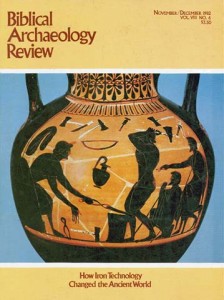Biblical Archaeology Review, November/December 1982
Special Section
What Does the Bible Say?
Translations speak in many tongues
Bible translations are nothing new. As early as the sixth century B.C. Babylonian Jews may have listened to translations (targums) of the Hebrew Toraha into Aramaic. While Ezra read the Torah to the returned exiles in Jerusalem, the Levites “read from the law of God, clearly, and...Read more ›
The New King James Version
First revision of classic bible in more than 200 years
Not since 1769 has the venerable King James Version of the Bible been revised. This year Nelson Publishers brought the King James Version into the twentieth century with care and reverence for its beloved cadences and familiar archaic language.a The King James Version of the Bible, originally...Read more ›
The Torah, The Prophets and The Writings—A New Jewish Translation
The publication of the third section of the Hebrew Bible, The Writings (Kethubim), marks the completion of the new Jewish Publication Society Bible translation, abbreviated NJPS.a This is the first Bible translation executed by a panel of Jewish scholars since the Septuagint, the Greek translation of the...Read more ›
Features
Has the House Where Jesus Stayed in Capernaum Been Found?
Italian archaeologists believe they have uncovered St. Peter’s home
Italian archaeologists claim to have discovered the house were Jesus stayed in Capernaum. Proof positive is still lacking and may never be found, but all signs point to the likelihood that the house of St. Peter where Jesus stayed, near Capernaum’s famous synagogue, is an authentic relic...Read more ›
How Iron Technology Changed the Ancient World and Gave the Philistines a Military Edge
Modern historians divide the roughly 3,000 year-period beginning approximately 3200 B.C. into two major segments—the Bronze Age and the Iron Age. The Bronze Age I extends from about 3200 B.C. to 1200 B.C.a Thereafter it is the Iron Age.b This is...Read more ›
A Bible Scholar Looks at BAR’s Coverage of the Exodus
Recent issues of BAR have covered a wide range of views regarding the Israelites’ servitude in Egypt, the parting of the “Red Sea” (the “Reed Sea” in Hebrew), and the route of the Exodus.a The authors were, in the main, archaeologists, linguists and experts in Near Eastern...Read more ›
BAR Jr.: "Lachish and Azekah Were the Only Fortified Cities of Judah That Remained" (Jeremiah 34:7)
Professor Larry Geraty of Andrews University gave his class in Biblical Archaeology the instructive assignment of writing a BAR Jr. column. In this issue, we print one of the papers submitted in response. Talk about bringing the Bible to life! Imagine you’re digging at a Judean outpost...Read more ›
Antiquities of Tyre Spared Despite PLO Occupation and War in Lebanon
BAR has been able to confirm a New York Times report that the famous antiquities of Tyre have not been seriously damaged either by the PLO occupation of the site or by the war in Lebanon. According to the Times, the PLO placed the ancient Roman ruins...Read more ›

